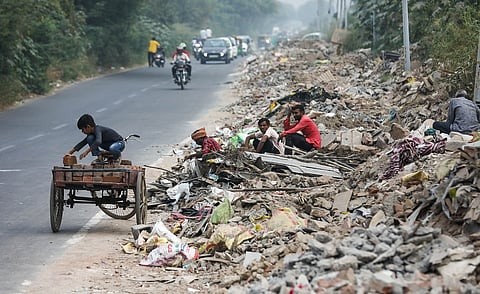



Waste management in India is a complex and multidimensional challenge, involving municipal, industrial, biomedical, e-waste, plastic, and agricultural waste. Rapid urbanization, population growth, and inadequate infrastructure have compounded the problem. The government has initiated several programs, including the Swachh Bharat Mission, Waste to Wealth Mission, and GOBARdhan Scheme, focusing on scientific disposal, recycling, energy recovery, and citizen participation. Effective waste management requires a holistic approach that integrates technology, policy, social inclusion, economic sustainability, and public awareness, transforming waste from a problem into a resource for environmental and economic benefits.

Copyright infringement not intended
Picture Courtesy: Down to Earth
India generates massive amounts of waste, which, if unmanaged, leads to pollution and health hazards. The Waste to Wealth concept seeks to transform this challenge into an opportunity by converting municipal, agricultural, and industrial waste into energy, compost, and recyclable materials.
|
Must Read: SOLID WASTE MANAGEMENT RULES, 2024 | SOLID WASTE MANAGEMENT | Solid Waste Management (SWM) Cess | Plastic-Free India: Challenges and Way Forward | |
The Waste to Wealth Mission is built on the principle of a circular economy, where materials are reused, recycled, and recovered rather than discarded.
It seeks to close the loop between production, consumption, and disposal, so that waste materials re-enter the economy instead of polluting the environment.
Significance;
|
Initiative Name |
Launch Year / Period |
Key Focus Areas |
|
Swachh Bharat Mission (Urban) 2.0 |
2021 – 2026 period |
Urban solid waste management: door‑to‑door collection, segregation at source, scientific processing, landfill remediation |
|
GOBARdhan Scheme (Galvanising Organic Bio‑Agro Resources Dhan) |
Launched around 2023 |
Rural organic waste / agricultural/cattle residue → biogas/compost; supporting “waste to wealth” in villages |
|
Waste to Wealth Mission |
Ongoing (since ~2022/2023) |
Innovate and deploy technologies across waste streams (municipal, plastic, e‑waste, construction waste) to recover value |
|
E‑Waste Management Rules 2022 |
2022 |
Regulation of electronic waste: collection, recycling, responsible disposal; part of extended producer responsibility |
|
Battery Waste Management Rules 2022 |
2022 |
Regulation of waste batteries, collection, recycling, safe disposal under producer responsibility |
|
Extended Producer Responsibility (EPR) scheme |
From ~2022 onwards |
Producers held accountable for lifecycle of products (plastic, e‑waste, batteries) — collection, recycling targets |
|
Plastic Waste Management Rules (Amended) |
Updated recently (~2024/25) |
Focus on packaging, recyclable/reusable plastic, reduction of single‑use plastic, industry responsibility |
Waste management in India is a complex, multidimensional challenge, involving environmental, social, and economic aspects. While significant progress has been made through government initiatives and innovative approaches, the path forward requires viewing waste as a resource, strengthening institutions, leveraging technology, and fostering citizen participation. A holistic, inclusive, and sustainable approach can transform India’s waste problem into an opportunity for wealth creation, energy recovery, and environmental resilience.
Source: Down to Earth
|
Practice Question Q. Discuss the concept of “waste to wealth” in India and its relevance to sustainable development. (250 words) |
Waste management refers to the collection, segregation, transportation, treatment, and disposal of waste in an environmentally sustainable manner. It also includes recycling and recovery of resources.
India faces a multidimensional challenge due to:
“Waste to wealth” is the idea of converting waste into valuable resources such as energy, compost, recycled materials, or biogas. It promotes circular economy principles and reduces dependence on landfills.







© 2025 iasgyan. All right reserved